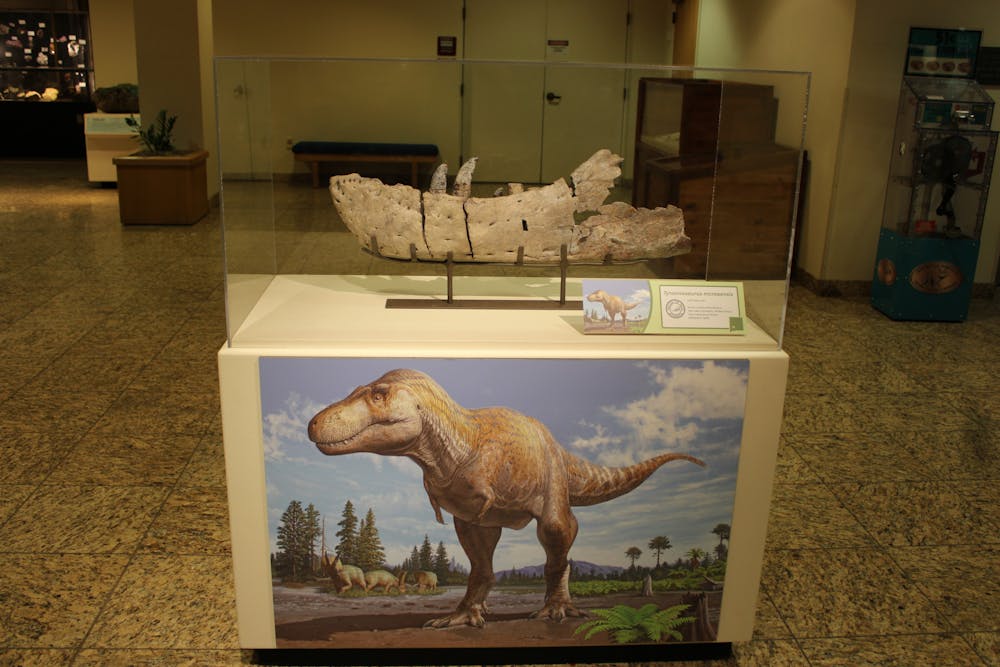Researchers have put a name to a dinosaur fossil discovered in New Mexico in the 1980s, identifying a new species of Tyrannosaurus that pre-dates the T. rex.
The findings were published Jan. 11 in the Scientific Reports journal. New Mexico Museum of Natural History & Science Curator of Paleontology, Spencer Lewis, and the museum’s executive director, Anthony Fiorillo, both are co-authors on the study.
The identification of Tyrannosaurus mcraeensis changes what paleontologists previously understood about the geographical origin of the T. rex. The standing idea, Lucas said, is the T. rex originated in Asia and immigrated over a land bridge to get to North America.
“This fossil doesn’t fit that story,” Lucas said. “This fossil now shows us a Tyrannosaurus that’s much older, geologically, in North America, and it’s even in the southern part of North America. So it raises the question: maybe Tyrannosaurus originated in what’s now the southwest.”
The fossil, a partial skull piece, was originally discovered on the eastern shore of Elephant Butte Reservoir in 1983 and categorized as a T. rex. In 2016, Sebastian Dalman – a former student of Lucas and one of the authors of the study – observed the fossil and said he did not believe it was a T. rex. From there, Lucas said he, Dalman and Forillo connected with other paleontologists and decided to write an article about the new species.
The Tyrannosaurus mcraeensis is believed to have existed about 6 million years before the T. rex, according to Lucas.
“When the fossil was first discovered, we weren’t sure exactly what its geologic age (was). Now, we have a much better handle,” Lucas said.
Paleontologists now ponder the relationship between T. rex and T. mcraeensis, as they do not know what happened in the 6 million year gap, Lucas said.
Unlike the T. rex, the T. mcraeensis had a long and low-set lower jaw. The T. rex had a larger, taller jaw, which means the bite force of the two species varied, according to Lucas.
T. mcraeensis also lacked the T. rex’s characteristic ridge on its skull, Lucas said. Such types of ridges are thought of as display structures, which help animals recognize each other. They were important for T. rex mating and behavior.
“It is worth noting that these differences are subtle, but the differences between species are often relatively subtle,” the study reads.
T. mcraeensis were about the same size – up to 40 feet. long and 12 feet tall – as these dinosaur species ate meat, according to a press release by NMMNHS.
Get content from The Daily Lobo delivered to your inbox
Historically, New Mexico has been a prime location for dinosaur discoveries because of its dry climate, Lucas said. The lack of vegetation and soil provides ideal conditions for a rich fossil record.
“New Mexicans have always known our state is special, now we know that New Mexico has been a special place for tens of millions of years,” Fiorillo said in the press release.
The partial skull of the T. mcraeensis is currently available for public viewing at NMMNHS. To continue research on the T. mcraeensis, Lucas said the next step is to go back into the field and search for more evidence.
“This is the typical story of paleontology. We never have enough fossils,” Lucas said. “Where there’s one, there’s got to be more.”
Lily Alexander is the news editor for the Daily Lobo. She can be reached at news@dailylobo.com or on Twitter @llilyalexander
Lauren Lifke is a beat reporter at the Daily Lobo. She can be reached at news@dailylobo.com or on Twitter
Lauren Lifke is the managing editor for the Daily Lobo. She can be reached at managingeditor@dailylobo.com or on Twitter @lauren_lifke
Lily Alexander is the 2024-2025 Editor of the Daily Lobo. She can be reached at editorinchief@dailylobo.com or on Twitter @llilyalexander






